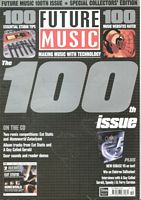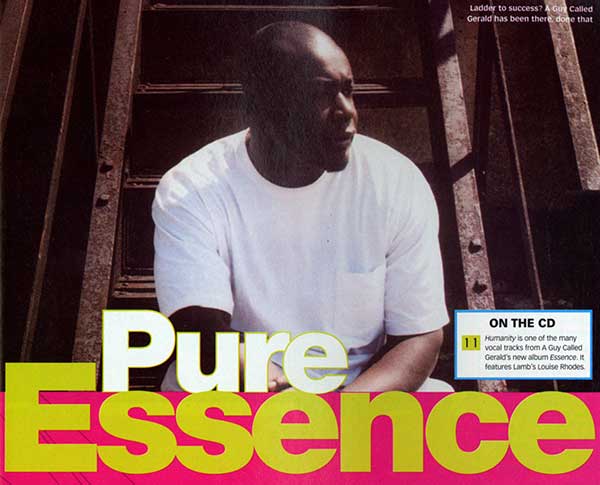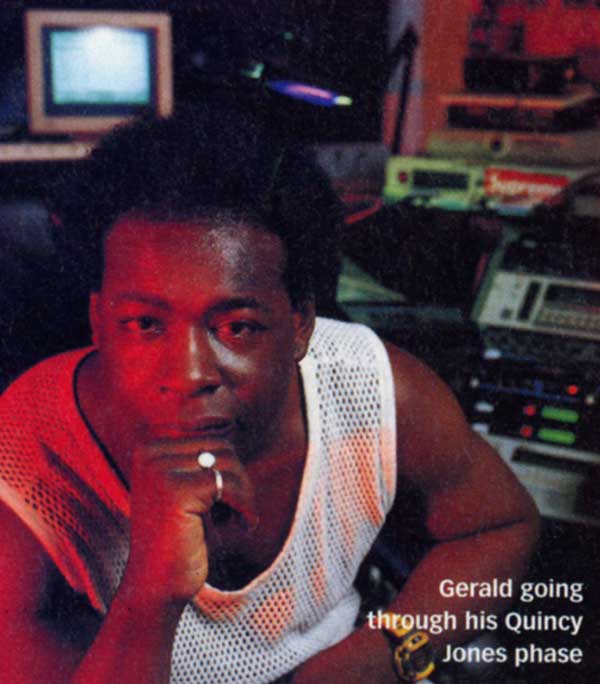| Pure Essence | |
 |
Future Music Issue 100 October 2000 Page: 91 |
 It's been a long journey for A Guy Called Gerald from the post-acid house generation classic Voodoo Ray to today's drum 'n' bass-influenced adventures. He talks to Gal Detourn about Essence, his first album in five years... GERALD SIMPSON IS a talented architect of sound who's faced problems with major labels that didn't 'get it' and worked with luminaries such as David Bowie and Tricky. Five years after his groundbreaking Black Street Technology comes Essence. It's a sophisticated, classy, atmospheric vocal-led journey - featuring Lamb's Louise Rhodes, Lady Kier and Wendy Page - utilising drum 'n' bass's dynamics, but going somewhere more interesting. Although Gerald now resides in the Big Apple, none of the city's brashness has polluted his manner. He is attentive, quietly spoken, thoughtful and ever the gentleman. So why has it taken someone who seems so together five whole years to finish this latest opus? What's he been doing? "Moving, growing and trying to get an angle on who I am as a person and what I'm trying to do," he sighs, "because it's been one bad experience after another. Someone would say, 'You should be doing it this way and the person you're working with is giving you a bad deal.' And I'd say, 'Oh yeah, you're right,' and go with them but end up with an even worse deal. I spent a long time sorting out the tangles I was getting into with people. And all the time the music was being pushed into the background." Getting vocal He's through that now and Essence is arguably his ' best album to date. But why is it so much more vocal? It was a progression," Gerald replies. "The first jungle stuff I did was 100% sampling and loop then with Black Street Technology I had a few vocal; I made this album so it could be adapted more easy to doing it live, so it was built around vocals." Maybe it's a case of not wanting to stand still or needing something different. After all, that's why he's moved around so much. "I went to London to get away from Manchester," explains Gerald. "I needed a different space to do my work. Then when I'd been in London for a few years, it was the same thing, I needed more input. I needed a change, a boost. I miss England though; fish and chips and football." Some artists need input to make their output, ands where else could you get more input than New York? In fact, it's given Gerald the opportunity to gain input in a very direct way: by sampling from inside his toilet. No, no, it's not what you're thinking. "My toilet has a vent that goes out on to the street," he explains, "so I can mic that up and it's like a direct link to the street; people getting busted outside my door and all sorts of crazy stuff." And does he record on the streets as well? "I used to carry just a MiniDisc recorder around, but now I carry a DV camera too, so I can get pictures. One thing I've got since I've been back in the UK is the screeching of red buses. I've recorded loads of things in New York though. I live in an active part of Brooklyn, so there's always things to record." "The problem with New York is it's so stagnant and inward looking for people who are poor. I wish Bill Gates' millions could be given to some of those kids so they could travel. It broadens the mind, but they're usually encouraged to stay where they are. Also, in New York they think I'm an African American. When I talk to people they're sometimes surprised there are black people in England. The generation I belong to grew up a little more educated that your average Brooklynite. They have a different heritage." Sample this! Sampled sounds, weaved into a track, are obviously an invaluable element in the modern musician's armoury, but Gerald's route into such practices had some underlying ulterior motives, like saving a beloved drum machine. "Yeah," he recalls, "I sat down and sampled all the sounds from my Roland TR-808. I was about to take it out on the road but the sync lead was wobbly and it had been a bit touch and go at gigs. It was replaced by the Akai MPC60 which had some really tight sequencing ability. I really valued the 808, from when I got it around 1985. It was always a cherished piece, but taking it out on the road meant it got battered." Gerald is pretty big on sampling but what sampling techniques does he use most? "Recently I've been really getting into the cutting and pasting of things with hard-disk recording," he outlines. "Taking sounds from the sampler, putting them into the computer, then just chopping them up, cleaning them up and putting them back into the sampler."  Hit the perfect beat The sampler, is of course, often the starting point for the other element of his music for which he is most known: rhythm. Gerald once said the beats represented his frustration to know the truth about his ancestors who talked with drums. Is he still feeling that frustration? "Totally," is his emphatic reply, "but it's only a small segment of what's going on. "I look at things as a whole, whereas things like that are more personal. To just look at my own ancestry alone would be indulgent. Jungle reflected that heritage though. I related to that music because it felt like it balanced something out in me. It's like saying, I'm doing this house music from Chicago and Detroit and adapting it, but it's not what I want. The house thing is a part of me, but what about the ska or the reggae? But it's not about being black or white. It's like it's all from the same tree, but it's branched off into different trees." So does he use any particular strategy when constructing his rhythmic contortions? "I'll sample a loop," Gerald explains, "then chop it up into lots of little bits and I'll maybe add other bits of drums that I overlay to give it some inflection or other. Sample CDs, banging things on the floor, all sorts. One time I got a good sound by bringing a paving slab into the studio and dropping a light bulb on to it from a height. There's not one way of doing it."  Gerald's drums might be loose and flowing in one sense, but they're also so tight they sound like they snap into place. It's a trait familiar to many drum 'n' bass records and Gerald has mastered it well. But how's it done exactly? "To get a 'feel' on some of the stuff," Gerald reveals, "I'll put it out of time, but because the loop's a little bit out, I'll have to end it before it's supposed to end, so I clip the last sound, and that gives that jolting, snapping effect." Getting an organic and free-flowing feel to the music is very much part of what A Guy Called Gerald is about. And although he uses a computer sequencer you won't be surprised to learn that screen-based sequencing is not Gerald's preferred method, but not necessarily for the obvious reason. "When I was younger," he recalls, "maybe using Cubase VI on the Atari, ha, those were the days, for some strange reason it always used to knock me out sitting in front of the screen. I found I had to go back to using the TR-808 or 909, because they had built-in sequencers. Nowadays, I only use Cubase for automation of my desk. I've tried chopping up drum loops on Cubase but it gets a bit tedious."  I'm a bass man He might be known for drums, but let's not forget that bass sound too. Essence not only features smooth sub bass punches but also a cool slice of double bass too. "Yeah, that double bass sound is actually from a keyboard," explains Gerald, "from a Yamaha RX3 or something like that. "For bass sounds, I usually use about three different things to make that low sound. The sub-harmonic part is just from a raw tone. I used to use the Roland SH-101, but now it comes from a number of things, like the Akai S900, 'cos you can go really low before it starts breaking up." So what does Gerald use to get started on a track? What is his creative scratchpad? "Hmm, it changes," he muses, "but at the moment I'm using a Korg ER-1, one of those Electribe things, but before I used some little Yamaha MIDI writing things. I also started using the MPC60 as a scratchpad. I'd go to gigs and do a live thing and save the good parts. I also dump a load of stuff on to two-inch tape then sample back the good parts. I like the warm quality of it." Means to an end However, as much as Gerald Simpson loves talking,; technology, he's the first to recognise that music technology is not an end in itself, but rather the means through which artists can make culture. "Yeah, music is a vessel," he asserts, "and if you can translate an idea via a machine, then you should do it, but as individually as possible. It's not about keeping up with the Joneses. See, music is important. The first sound we heard was our mother's heartbeat. We were a mass of cells evolving into a piece of intelligence, and our first awareness of anything was sound. The first awareness that your consciousness has of anything other than itself, is sound, so that's why it's important." [Author: Future Music] |
|
Vintage please "I do virtually have my own museum of analogue gear, but it's all here in the UK. I'd quite like to do a project with some of that stuff one day. There are vocoders, loads of old keyboards, old Rolands like SH-02s, different SH-101s, modified 303s. They're maybe worth a bit now, but when I started it was simply the only way I could afford to do it, you know, to go round to these second-hand shops and buy old equipment. "Back when I did an interview with Roland's magazine, they'd ask things like, 'If you had an ideal keyboard what would it be like?' This was back when everyone was raving about digital. So I told them it'd be better if you could turn the knobs and get direct control, to combine the digital with analogue control. Now those machines do exist. "I think there's something classic about a lot of that old gear though. Like today, even with the Nords, you still have to struggle to get the frequencies, but with the older stuff. it's there." |
|
Gerald on: Major labels "I think the labels are starting to understand the scene a bit more, now it's a younger crowd. But they're gonna have to catch up on the whole computer thing. They're too insular. They're supposed to go out and look for talent, but I think they've got to the stage where they're happy to just manufacture that talent. Then they buy the press, the radio system, the charts. You could have Elvis singing on your record, but if you're not in with the right people..." Gear nightmares "I tell the truth, because these companies need to know what works and what doesn't. I'd say there's always some good in machines, but I remember a Tascam DAT that just broke down. The other thing, with the Akai samplers, the screens don't really last that long and it costs loads to replace the backlight. Also, there's the Roland JP-8000. It has really weird MIDI problems and throws out weird MIDI messages." Sponsorship "I'd love to get endorsements, then I'd keep up to date! I could road test gear for them. I think these people should seriously think about sponsoring me to endorse their products, because for years people have been asking me what gear I use and how I use it. I remember having to let loose the secret that the 303 was the acid machine, back in the 80s. I should definitely be testing gear." Spirituality "I think everyone is spiritual, but a lot of people don't really see it or take any notice of it. I don't mean it in a religious way like some of the profit-making organisations around, but in the sense of people looking at things as a whole. I admire some of the things Buddhists do." |
|
 Discography Automanikk - Columbia (1989) |
|
 Selected kit list Akai MPC2000 |
|